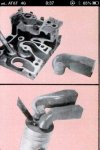merlot566jka
Member
- 360
- 0
- 16
- Location
- ID or TX or OK
Had my heads off last week and valves out. Looking in the ports, I was curious about the flow on them. Has anyone ever flow benched a head?
Also noticed there is a ton of metal there if anyone were to port them...
Looked around some other diesel forums out of curiosity to see if porting yielded the same effects as it does on gas performance engines. From what I saw, there wasn't much scientific data, but tons of "lowered my EGT..." "Bunch of turbo lag..." "Can't tell a difference..."
So I analyze it a bit. A compression ignition engine uses no throttle plate. So every intake stroke, the engine is trying to suck in as much air as the port will let in. Add a turbo, and the engine is being force fed air. That means (if) the turbo is appropriately sized, the volume of air should be the same, just increased pressure... If you increase pressure, volume stays the same....air speed increases?
Would a better flowing port actually do anything at the level we use the engine? The only thing I see is a decrease in pumping loss, which I believe is more than equalized with a turbo.
This leads to more thinking...
If you had ports on the multifuel that flowed (example) 200CFM and that was adequate for the engine from factory, would there be any benefit to a port that flowed 300 CFM? Aside from amount of time it takes to fill the cylinder and efficiency of cylinder filling, what are we accomplishing with better ports?
Now if we INCREASE the amount of air being forced into the engine (higher volume turbo) then I could see where a head that flowed more air in/out would be helpful. But to port a stock engines' heads, why?
To bring this all back around, what does the deuces heads flow on the intake side? Is it more or less than the engine uses at 2650rpm?
If 100% efficient, we need 360cfm for the entire engine at 2650rpm. 360/6= 60cfm per intake port
If 70% efficient, we need 250cfm for the entire engine. 250/6= 41.667 CFM per intake port.
I haven't measured anything, but just looking at those ports and the size of the valves, they should easily flow 60 CFM.

Also noticed there is a ton of metal there if anyone were to port them...
Looked around some other diesel forums out of curiosity to see if porting yielded the same effects as it does on gas performance engines. From what I saw, there wasn't much scientific data, but tons of "lowered my EGT..." "Bunch of turbo lag..." "Can't tell a difference..."
So I analyze it a bit. A compression ignition engine uses no throttle plate. So every intake stroke, the engine is trying to suck in as much air as the port will let in. Add a turbo, and the engine is being force fed air. That means (if) the turbo is appropriately sized, the volume of air should be the same, just increased pressure... If you increase pressure, volume stays the same....air speed increases?
Would a better flowing port actually do anything at the level we use the engine? The only thing I see is a decrease in pumping loss, which I believe is more than equalized with a turbo.
This leads to more thinking...
If you had ports on the multifuel that flowed (example) 200CFM and that was adequate for the engine from factory, would there be any benefit to a port that flowed 300 CFM? Aside from amount of time it takes to fill the cylinder and efficiency of cylinder filling, what are we accomplishing with better ports?
Now if we INCREASE the amount of air being forced into the engine (higher volume turbo) then I could see where a head that flowed more air in/out would be helpful. But to port a stock engines' heads, why?
To bring this all back around, what does the deuces heads flow on the intake side? Is it more or less than the engine uses at 2650rpm?
If 100% efficient, we need 360cfm for the entire engine at 2650rpm. 360/6= 60cfm per intake port
If 70% efficient, we need 250cfm for the entire engine. 250/6= 41.667 CFM per intake port.
I haven't measured anything, but just looking at those ports and the size of the valves, they should easily flow 60 CFM.





